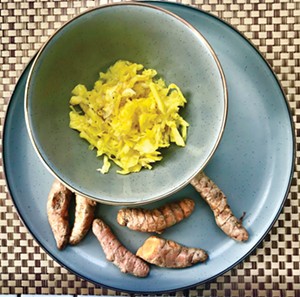Even though I've been living away from Springfield for the past 10 months I still get text messages out of the blue from my former CrossFit coach Mike Suhadolnik. Mike is an audacious crusader obsessed with helping older people reclaim wellness in the second half of life. He has taken on the medical establishment and Big Pharma and has no concerns about rocking the boat.
Last month I received this message during the peak of dinner service at the restaurant where I work: "I know you are busy. Compton Rom, a noted microbiologist, made the comment that if we ferment turmeric it explodes in its effectiveness in eliminating inflammation. How would you go about fermenting turmeric? Thank you."
I have a pretty broad experience with fermentation and gallon jugs of sauerkraut and kimchi bubble away on my kitchen counter, but I've never worked with fresh turmeric. I've always had a little jar of powdered turmeric tucked away amongst my infrequently used spices, but the only dishes I remember ever using it for were butternut squash risotto and Indian curries and I felt its primary function in the dish was to impart a pretty yellowish orange color rather than adding flavor.
Turmeric is a rhizome that looks a bit like ginger, only yellowish-orange and smaller. It has a slightly bitter taste and is a powerful anti-inflammatory. Turmeric supplements have become quite popular as a treatment for sore and achy joints. A study published in the Journal of Alternative and Complementary Medicine in 2009 compared the effectiveness of curcurmin, the active ingredient in turmeric, to ibuprofen for relief of pain in 107 patients with osteoarthritis of the knee. Curcurmin was found to be as effective as ibuprofen in relieving pain and improving function.
Turmeric by itself is poorly absorbed by the gut and needs to be paired with piperine, a compound found in black pepper, in order to be optimally absorbed. Combining turmeric with piperine increases its bioavailability by 1,000 times. Turmeric is fat-soluble and in Indian cooking turmeric is often cooked with pepper in clarified butter known as ghee. Fermenting turmeric also improves the ability of our gut to absorb it.
After receiving Mike's message I made a mental note to go to my nearby Asian grocer to buy some fresh turmeric and see what I could come up with. The Christmas holidays came and went and the turmeric fermentation project never made it to the top of my to-do list... until I received this follow-up text message from Mike: "I bought a pound and a half of turmeric root. After 2 months it was finally restocked at Meijer." Mike is an imposing figure and has a way of getting me to rearrange my priorities so on my day off I went to Super Cao Nguyen and bought up all their fresh turmeric.
Like its cousin ginger, the best way to peel turmeric is to scrape it with the side of a spoon. Microplane's 3-in-1 ginger tool is an easy and effective way to grate it.
Turmeric is one of the most staining substances in the kitchen, even worse than beets, so gloves should be worn when working with it. Fresh turmeric should be stored in the refrigerator, loosely wrapped so it doesn't mold. Like ginger, you can also freeze turmeric. It will be mushy when it thaws out, but fine to add to your dish. One inch of fresh turmeric will yield about a tablespoon of grated turmeric and will be equivalent to 1 teaspoon of powdered.
I try to eat a serving of fermented vegetables every day. In addition to repopulating the gut with beneficial bacteria, fermenting vegetables increases the gut's ability to absorb it. I did not find turmeric, when fermented alone, to be very palatable, so I combined it with cabbage and made a kraut. The addition of black pepper to my ferment introduced the piperine that turmeric's curcurim needs to be optimally effective. The resulting kraut has a beautiful sunny yellow hue and is quite delicious.
Turmeric and Black Pepper Kraut
Ingredients
1 small head cabbage (about 1 ½-2 lbs)
1 small yellow onion, sliced
1 ½ tablespoons unrefined sea salt
1 ½ tablespoons finely grated fresh turmeric root
1 large cloves garlic, grated
½ teaspoon freshly ground black pepper
Preparation
Remove any blemished outer leaves from the cabbage. Cut the cabbage into quarters and thinly slice with a sharp knife or mandoline, and transfer to a large bowl. Thinly slice the onion and add to the cabbage.
Sprinkle 1 ½ tablespoons of salt over the cabbage/onion mixture. Massage the salted cabbage for about 10 minutes until it releases its liquid. Set aside for 15 minutes to allow the cabbage to weep.
Add the turmeric, garlic and pepper. Taste the mixture. It should taste pleasantly salty. Add more salt if necessary.
Pack the cabbage very tightly into the jars. Pour any liquid from the bowl into the jar. Make sure the liquid entirely covers the cabbage. Leave about 2 inches of head space. Fill a small resealable plastic bag with water and a little salt, express the air from the bag, and place on top of the cabbage to keep it submerged. Filling the bag with salted water will keep the brine from being diluted if the the bag should leak.
Cover the jar with a clean towel and a rubber band. This will allow airflow, but prevent dust and insects from getting into the kraut. Lids with airlocks can also be used.
Place jars in a place where the temperature is ideally between 64 and 67 degrees. Cooler temperatures will slow down the fermentation. Higher temperatures cause the cabbage to ferment too fast and become mushy.
After two weeks taste the kraut. Depending on your personal taste, it may have reached its desired tartness. If you like stronger flavored kraut, allow it to ferment for one to three weeks longer. When the desired flavor is reached, store in the refrigerator. It should be good for six months to a year.
It is normal to see bubbles, white scum or foam on top during the fermentation. If you see any mold, carefully scrape it off the top, and make sure all the rest of the cabbage is fully submerged. This will not affect the kraut below the liquid level.



















